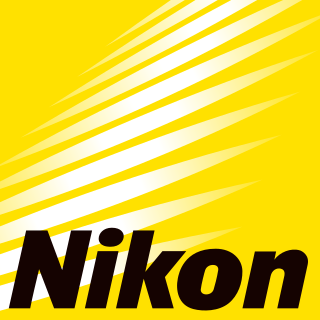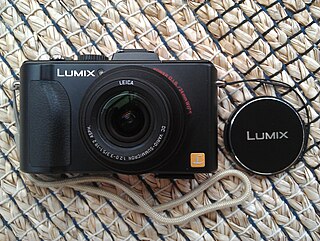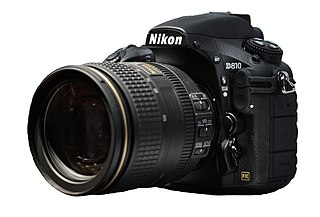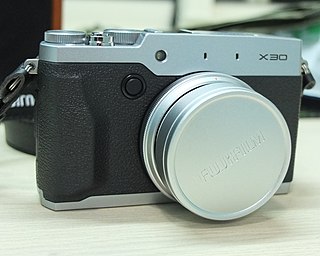
A digital camera is a camera that captures photographs in digital memory. Most cameras produced today are digital, largely replacing those that capture images on photographic film. Digital cameras are now widely incorporated into mobile devices like smartphones with the same or more capabilities and features of dedicated cameras. High-end, high-definition dedicated cameras are still commonly used by professionals and those who desire to take higher-quality photographs.

Nikon Corporation, also known just as Nikon, is a Japanese multinational corporation headquartered in Tokyo, Japan, specializing in optics and imaging products. The companies held by Nikon form the Nikon Group.
The Nikon Coolpix series are digital compact cameras in many variants produced by Nikon. It includes superzoom, bridge, travel-zoom, miniature compact and waterproof/rugged cameras.

A digital single-lens reflex camera is a digital camera that combines the optics and the mechanisms of a single-lens reflex camera with a digital imaging sensor.

The Nikon D200 is a 10.2-megapixel digital single-lens reflex camera that falls between entry-level/midrange DSLR cameras such as the Nikon D40, Nikon D40x, and D80 and high-end models such as the Nikon D2Hs and D2Xs. It was released by the Nikon Corporation in November 2005. The D200 was succeeded by the D300 in August 2007.

The Nikon Coolpix 4300 is a digital camera that was made by Nikon. It was first released on October 1, 2002, and is no longer in production. At 4.0 effective megapixels, it is capable of delivering 2,272 × 1,704 pixel images. An included lens cap protects its Nikkor 3× optical Zoom lens, with a focal length of 8 to 24 mm, as well as an aperture of f/2.8–4.9 and shutter speed of 8–1/1,000 sec. It is capable of ISO equivalents of 100, 200, and 400.

The Coolpix 5400 was a 5.1 megapixel 'prosumer' digital camera produced by Nikon. Announced at the end of May 2003 as the immediate successor to the Nikon Coolpix 5000, it features 4x optical zoom, 4x digital zoom, and many other functions.

The Nikon D700 is a professional-grade full-frame digital single-lens reflex camera introduced by the Nikon Corporation in July 2008 and manufactured in Japan. It uses the same 12.1-megapixel "FX" CMOS image sensor as the Nikon D3, and is Nikon's second full-frame digital SLR camera.

The Coolpix P6000 is a digital camera introduced by the Nikon Corporation in August 2008.

The Nikon D90 is a 12.3 megapixel digital single-lens reflex camera (DSLR) model announced by Nikon on August 27, 2008. It is a prosumer model that replaces the Nikon D80, fitting between the company's entry-level and professional DSLR models. It has a Nikon DX format crop sensor.

The Nikon D3S is a 12.1-megapixel professional-grade full frame (35mm) digital single-lens reflex camera (DSLR) announced by Nikon Corporation on 14 October 2009. The D3S is the fourth camera in Nikon's line to feature a full-frame sensor, following the D3, D700 and D3X. It is also Nikon's first full-frame camera to feature HD (720p/30) video recording. While it retains the same number of pixels as its predecessor, the imaging sensor has been completely redesigned. Nikon claims improved ultra-high image sensor sensitivity with up to ISO 102400, HD movie capability for extremely low-lit situations, image sensor cleaning, optimized workflow speed, improved autofocus and metering, enhanced built-in RAW processor, quiet shutter-release mode, up to 4,200 frames per battery charge and other changes compared with the D3. It was replaced by the D4 as Nikon's high speed flagship DSLR.

The Nikon D3100 is a 14.2-megapixel DX format DSLR Nikon F-mount camera announced by Nikon on August 19, 2010. It replaced the D3000 as Nikon's entry level DSLR. It introduced Nikon's new EXPEED 2 image processor and was the first Nikon DSLR featuring full high-definition video recording with full-time autofocus and H.264 compression, instead of Motion JPEG compression. It was also the first Nikon DSLR to provide high-definition video recording at more than one frame rate.

The Nikon D7000 is a 16.2-megapixel digital single-lens reflex camera (DSLR) model announced by Nikon on September 15, 2010. It replaced the D90 as the top end consumer camera, by using much of the technology and controls from the earlier D5000, in a larger more robust body similar to the flagship D300 series. In some ways it was superior to the D300S, though for several years the two cameras were both available with the D300 positioned as the flagship in Nikon marketing materials.

The Panasonic Lumix DMC-LX5, or LX5, is a high-end compact "point and shoot" camera launched by Panasonic in 2010 to succeed the LX3.

The Nikon D5100 is a 16.2-megapixel DX-format DSLR F-mount camera announced by Nikon on April 5, 2011. It features the same 16.2-megapixel CMOS sensor as the D7000 with 14-bit depth, while delivering Full HD 1080p video mode at either 24, 25 or 30fps. The D5100 is the first Nikon DSLR to offer 1080p video at a choice of frame rates; previous Nikon DSLRs that recorded 1080p only did so at 24 fps. It replaced the D5000 and was replaced by the D5200.

The Nikon D7100 is a 24.1-megapixel digital single-lens reflex camera model announced by Nikon in February 2013. It is a 'prosumer' model that replaces the Nikon D7000 as Nikon's flagship DX-format camera, fitting between the company's entry-level and professional DSLR models. This camera is the first ever of Nikon, with no optical low-pass filter incorporated. At launch, Nikon gave the D7100 estimated selling price in the United States as US$ 949.95 for the body.

The Nikon Coolpix A is digital large-sensor compact camera announced by Nikon on March 5, 2013. It is Nikon's first consumer-oriented camera with a DX (APS-C) sensor, announced on March 5, 2013. It is the company's flagship Coolpix camera, but has Program/Shutter priority/Aperture priority/Manual (PSAM) modes and menu system which is much more similar to a DSLR than its Coolpix predecessors.

The Nikon D810 is a 36.3-megapixel professional-grade full-frame digital single-lens reflex camera produced by Nikon. The camera was officially announced in June 2014, and became available in July 2014.

The Fujifilm X30 is an advanced digital compact camera announced by Fujifilm on August 26, 2014. It succeeds the Fujifilm X20 whose 12 megapixel X-Trans CMOS sensor it shares. The X30 abolishes the tunnel optical viewfinder of the X20 and offers an electronic viewfinder instead. In terms of more advanced compact cameras, it occupies the middle ground between the Canon PowerShot G16 and Nikon Coolpix P7800 on the one hand, and Sony RX100 series and Canon PowerShot G1 X series on the other. In terms of Fujifilm's own product line, it is positioned as a more compact and affordable model than the Fujifilm X100S, which has a larger APS-C sized sensor that records 16 megapixels.

The Nikon Coolpix P610 is a superzoom bridge camera announced by Nikon on February 10, 2015.



















